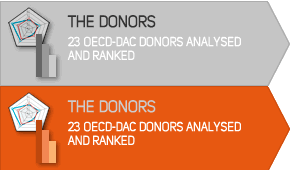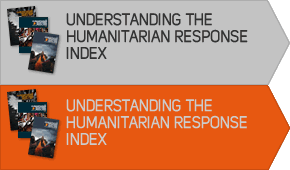Donors have a special responsibility to ensure that their policies and decisions help uphold and promote impartial, neutral, independent and effective humanitarian action. Over the past four years, DARA’s Humanitarian Response Index (HRI) has monitored and assessed donor humanitarian assistance in five pillars of practice:
- Pillar One: Are donors’ responses based on the needs of the affected population and not subordinated to political, strategic or other interests?
- Pillar Two: Do donors support strengthening local capacity and resilience, prevention of future crises, and long term recovery?
- Pillar Three: Do donors’ policies and practices effectively support the work of humanitarian organisations?
- Pillar Four: Do donors respect and promote international humanitarian law (IHL), and actively support safe and unrestricted access to and protection of civilians affected by crises?
- Pillar Five: Do donors contribute to quality, effectiveness, accountability and learning in humanitarian actions?
This year, we are producing a thematic report on the following issues identified from our field research in each of these five pillars: Gender, Needs-based Responses, Local Capacity, Humanitarian Reform, Safe Humanitarian and Protection of Civilians, and Transparency and Accountability.
In addition we will be examining the specific issue of gender in humanitarian crises, and what donors can do to ensure gender-sensitive approaches are incorporated into crisis responses.
Gender
Despite years of efforts to mainstream gender sensitive approaches in responses to crises, DARA’s research over the past four years shows that progress has been slow. Too often the specific and different needs of women and girls, men and boys are not considered by humanitarian agencies in the immediate response or in long-term recovery efforts, undermining the principle that aid is impartial, non-discriminatory, and based on needs. Donors have an important role to ensure that the organisations they support fully integrate a gender analysis in their programmes. The HRI 2011 research this year will specifically look for examples of good and poor practice of integrating gender in emergencies, and look for practical recommendations on how to improve the quality and effectiveness of aid efforts for all affected populations: women and girls, men and boys.
Needs-based Responses
The Humanitarian Response Index 2010 raised the issue of growing politicization of aid in 10 of the 14 crises studied, such as Somalia, Afghanistan and the Occupied Palestinian territories. Despite commitments to keep their humanitarian assistance neutral, impartial and independent, political, security and military interests have driven the responses of many donors, rather than actual needs. One argument sometimes used by donors is that appeals and needs assessments done by humanitarian organizations are not accurate or reliable, limiting their ability to make informed decisions on aid allocations.
This year’s HRI will look in more detail at how donors are using needs assessment tools to prioritize and allocate their aid. The HRI will also review current efforts to develop needs assessment tools that can be used at the global, regional and local level to predict and anticipate risks and vulnerabilities, determine the level and extent of needs in crisis situations, and make informed, objective decisions on where, when and how to allocated and distribute aid.
Local Capacity
Over the past four years, the HRI has revealed a persistent lack of political commitment and investment in capacity-building, conflict and disaster prevention, preparedness and risk reduction. On average, donor governments score 30% lower in indicators in these areas, despite widespread agreement and commitments by donors that investing in building local capacity and resilience to prevent, prepare for and respond to crises is both cost-effective and contributes to preventing and alleviating human suffering. An underlying principle common to most quality and accountability initiatives in the humanitarian sector is that engagement and ownership of vulnerable and crisis-affected populations is essential for success programmes.
This year’s HRI will review the extent to which donors invest in strengthening local capacity and resilience, highlighting examples of good and poor practice, and offering recommendations on how local capacities can be better integrated with crisis prevention, preparedness and response mechanisms used by the humanitarian sector.
Humanitarian Reform
For several years now, the humanitarian sector has been engaged in a reform process aimed at improving the efficiency and effectiveness of responses to crises. Some initiatives have included the establishment of Humanitarian Coordinators to lead and coordinate responses, pooled funding mechanisms, such as CERF (Central Emergency Response Fund), and clusters. HRI research over the past four years shows that the results have reform efforts have been mixed, and that leadership is critical to assure an effective and coordinated humanitarian response.
The HRI 2011 will look in greater detail at the current status of reform efforts, and the role of donors in building and strengthening the capacity of the humanitarian sector to prevent, prepare for, and respond to increasingly complex and more frequent humanitarian crises.
Safe Humanitarian Access and Protection of Civilians
Two challenges consistently highlighted in HRI research over the past four years are the continued lack of safe humanitarian access to populations in need of assistance, and the disregard of some actors in a crisis to fulfil their responsibilities to protect and provide assistance to civilians. In too many crises, populations and humanitarian organisations are often deliberately targeted for violent actions, and as a result, populations in need are denied access to life-saving assistance. There are no easy solutions to this dilemma, but donor governments can and must do more to find ways to support actions that contribute to safe access and protection of civilians.
This year’s HRI will look at the different issues facing the sector, such as the challenges of effective civil-military collaboration in humanitarian crises, linking humanitarian actions with political advocacy on issues of access and protection, or situations where political, economic or security interests of donor governments intersect with humanitarian crises.
Transparency and Accountability
As in previous years, the Humanitarian Response Index 2010 found that donor governments are collectively failing to improve their transparency and “downward” accountability towards affected populations. Donor governments need to significantly increase transparency around their funding and support for humanitarian action, and improve their accountability to help ensure that aid efforts have the greatest possible benefit for crisis-affected populations.
The HRI 2011 will explore in greater detail how donors can better support and promote good practice, quality standards and accountability with the organizations that they fund, while improving their own policies and practices to be more transparent and accountable to crisis-affected populations, as well as to their own domestic stakeholders and internationally.







Share this